U.S. Highlights
- Not even a looming government shutdown could dampen market optimism this week. More evidence of strong momentum in the economy saw equities gain ground, while Treasuries and the U.S. Dollar continued to fall.
- It remained a coin toss at time of writing whether Congress will reach a funding deal to avert a government shutdown at midnight. If government shuts down, many non-essential services won’t operate, and employees will not be paid.
- For markets, shutdowns have been modest negatives in the past. However, markets rallied in the last three. All told the U.S. economy has very solid momentum heading into 2018. A closure would be a slight hit to growth, but not derail the U.S. expansion.
Canadian Highlights
- As expected, the Bank of Canada this week raised its key interest rate by 25 basis points, putting the overnight policy rate at 1.25%. However, the decision was accompanied by a dovish tone, justified by the downside risks to the outlook.
- It appears that homebuyers pulled forward purchases into last fall, ahead of the B-20 guidelines that took hold at the start of this year. We anticipate that existing home sales will be dampened by the new guidelines, particularly as the qualifying mortgage rate rises further above 5%.
- All told, the key message from this week’s interest rate decision is that interest rates are headed higher. However, downside risks warrant a gradual pace of increase.
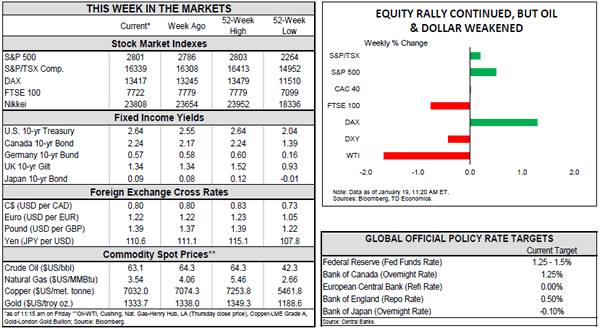
U.S. – Headed for a Shutdown?
Not even a looming government shutdown could dampen market optimism this week. Equities continued to rally, and Treasury yields rose as the bond market becomes increasingly convinced that the improved momentum in the global economy is for real, and that inflation pressures may be starting to build.
As for that looming shutdown, the House passed a stop gap spending bill that would fund the government until February 16th, but it faces an uphill battle in the Senate. Any continuing resolution to fund the government needs 60 votes in the Senate, and the GOP only has 51 seats so it needs Democratic votes. Dems are opposed to the bill because they want it to deal with the fate of "Dreamers" – people who were brought to the U.S. illegally as children – whose protection from deportation expires in March. Congress has until then to pass a bill to address the Dreamers, but Dems are trying to use their leverage in the Senate to force the issue now. It is a political game of chicken, and at time of writing it is unclear whether a compromise can be reached by midnight tonight.
So, what happens if they don’t reach a deal? Well, we have a fair bit of experience with shutdowns – there have been 18 "funding gaps" since 1976, and three full shutdowns. The most recent shutdown in 2013 led to about 40% of federal government workers being furloughed, the equivalent of about 850,000 people.
In the event of a shutdown, essential services will remain in place, including roles like air-traffic controllers, armed forces, and law enforcement. The Federal Reserve is not funded by Congress, so it too would remain open for business. But, many "non-essential" operations would be closed, like national parks, statistical agencies and the IRS, causing disruption in the lives of many Americans, particularly those federal employees who will not be paid during the shutdown.
This would have a negative effect on growth in Q1. The Bureau of Economic Analysis (BEA) estimated that the last 16-day shutdown lowered real GDP by 0.3 percentage points (annualized) in Q4 2013. If the shutdown were to drag on, for example, for four weeks, it is estimated it would lower real GDP growth by 1.5 percentage points (annualized). Right now, first quarter growth is tracking just shy of 2 ½% annualized, strong enough to withstand the hit.
In the past, shutdowns have not been catalysts for market downturn. On average, markets have shown modest weakness, with the S&P 500 down 0.6% over the period of the closure. However, the index rose in 44% of past government shutdowns. In fact, during the last three, under Clinton & Obama, markets rallied. Given current market optimism on strong global growth, it seems unlikely that a shutdown would derail the rally.
Markets do have solid economic reasons for optimism. Next week we see the first estimate of fourth quarter growth. We expect the U.S. economy ended 2017 with solid momentum at a near 3% annualized pace (Chart 2). That would corroborate the recent Beige Book, which showed widespread momentum across the country.
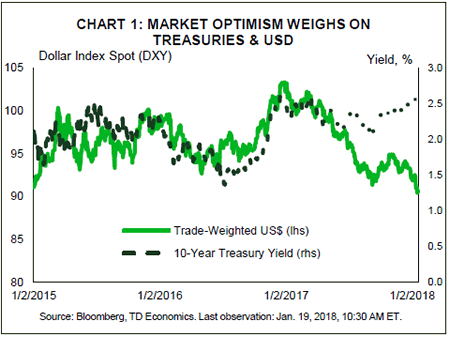
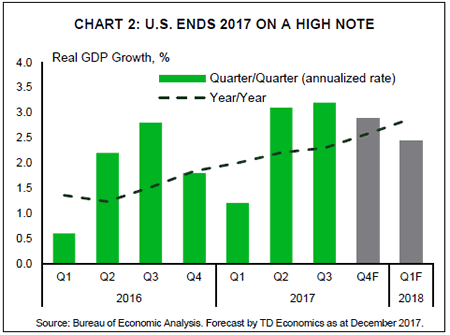
Canada – One Rate Hike Done, One or Two More Still to Come
As expected, the Bank of Canada this week raised its key interest rate by 25 basis points, putting the overnight policy rate at 1.25%. However, the dovish tone accompanying the decision in both the monetary policy statement, press conference, and a later interview with BNN, was apparent. Indeed, the Bank of Canada sees trade policy uncertainty, together with the elevated sensitivity of highly-indebted households to interest rates, as factors that justify the need for at least some ongoing monetary accommodation.
Although the Canadian outlook was largely unchanged, it was clear that Bank of Canada staff had done a lot of work estimating what ultimately became offsetting impacts from U.S. tax reform on the business investment outlook. It was a similar story for exports, where trade policy uncertainty offset a stronger U.S. outlook, leaving the Bank’s forecast effectively unchanged. Lastly, stronger momentum heading into 2018 lifts the outlook for household consumption in 2018, but spending is still expected to fall back through 2019 as higher interest rates and inflation begin to eat away at purchasing power.
Overall, despite some uncertainty on potential growth, Canada’s economy is forecast to continue expanding at an above trend pace again this year, with wage and price pressures firming up. This suggests that the Canadian economy will be running a little hot, and is consistent with at least one more rate hike this summer, possibly two, particularly if NAFTA uncertainty diminishes or consumer spending continues to defy expectations.
.With the policy rate set to rise to 1.50% or 1.75% this year, consumer and business rates will also rise in tandem. Although still historically low, higher mortgage rates could work to exacerbate an expected decline in housing activity this year. Indeed, regulatory underwriting guidelines that require mortgage applicants to pass an income stress test at a qualifying rate that is now over 5% (Chart 1) and rising should have a negative impact on activity (Chart 2). The last time posted mortgage rates were this high was in February 2014.
In anticipation of these changes that took effect at the start of this year, homebuyers appeared to have rushed to buy at the end of last year. Existing home sales rose 4.5% in December, the fifth consecutive monthly gain. The sales slowdown that followed provincial housing actions this past spring is now in the rearview mirror. Although new listings rose strongly in December, the sales to new listings ratio rose to 58%, right on the edge of a sellers’ market. Home prices also continued to recover, rising for the fifth consecutive month as well, but the average Canadian home price remains about 3% below its April 2017 peak.
All told, the key message from the Bank of Canada’s decision this week is clear: interest rates are on the rise. The economy is no longer in recovery mode, but in full-on expansion, operating near full capacity. It’s no longer a question of if, but when the Bank of Canada will be raising interest rates next. Moreover, the pace of increases will be governed by three factors: the progress of underlying inflation toward target; trade-related uncertainty; and the degree to which higher interest rates impact economic activity.
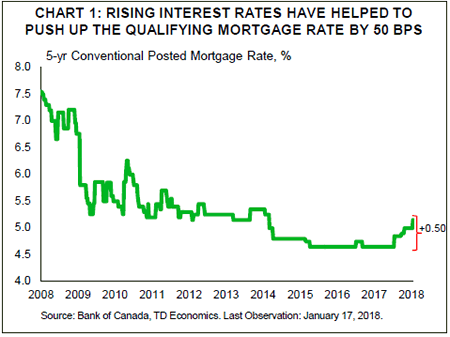
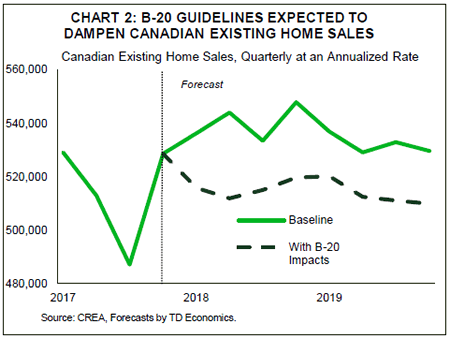
U.S.: Upcoming Key Economic Releases
U.S. Real GDP – Q4 Advance Estimate
Release Date: January 26, 2018
Previous Result: 3.2%
TD Forecast: 2.9%
Consensus: 2.9%
We expect Q4 real GDP to clock in at a 2.9% rate, reflecting a robust advance in consumer spending. Other positive details include solid growth in business investment. One wildcard is net exports, which we expect to be a significant drag, but markets should take a hawkish signal from strong domestic demand components.
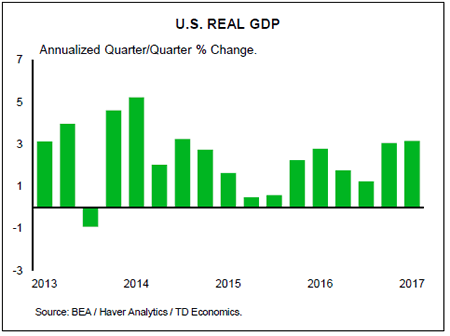
Canada: Upcoming Key Economic Releases
Canadian Retail Sales – November
Release Date: January 25, 2018
Previous Result: 1.5% m/m, ex-auto: 0.8% m/m
TD Forecast: 0.8% m/m, ex-auto: 0.7% m/m
Consensus: N/A
November retail sales are forecast to rise 0.8% m/m on a broad advance. Auto sales should make a positive contribution on stronger commercial vehicle sales while a surge in gasoline prices will provide a nominal tailwind to gasoline station receipts. While auto sales should outperform the headline print, we expect the ex-autos metric to come in just slightly weaker at 0.7% m/m while core (ex-autos and gas) retail sales should see a more modest advance. Employment data (jobs, hours) is consistent with a solid headline print and strong Black Friday sales should also provide a tailwind. Real retail sales are likely to come in just below the nominal print due to a modest increase in CPI, which would be consistent with Q4 consumer spending near a 3% pace.
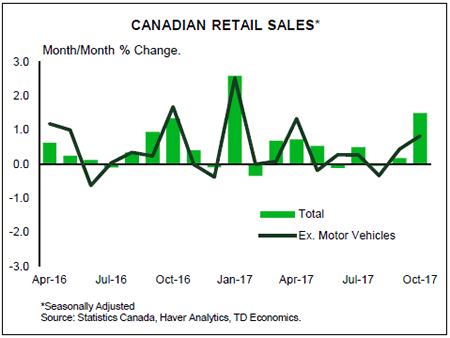
Canadian CPI – December
Release Date: January 26, 2018
Previous Result: 0.3% m/m
TD Forecast: -0.3% m/m
Consensus: N/A
We expect headline CPI inflation to ease back to 1.9% y/y in December on a reversal in gasoline prices. Food prices have scope for a sustained rebound helped by stabilization in the Canadian dollar. In addition, vehicle prices could also hold firm on the back of better price gains in the US. Exclusion based core indexes (CPIXFE or CPIX) should pick up on balance but the BoC core metrics (CPI common, trimmed mean and median) have more limited scope for a further acceleration given the sharp improvement in prior months. We thus expect stabilization in the latter. One source of downside risk this month is cellphone services, as the Big 3 telecoms temporarily offered cheaper data plans in December in response to Freedom Mobile’s offering. The apparel category is also exposed to a large drop. Overall, risks are skewed to the downside in our forecast.

